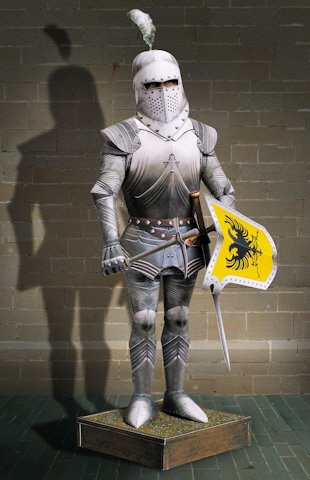Knight in Armour

scale 1:9
length 10 cm
width 9 cm
height 25 cm
degree of difficulty 2
number of sheets 3
Knight in Armour
The German word for "knight" is "Ritter", and in Middle High German it first simply meant "Reiter" (rider), being used in the Middle Ages for the heavily armoured warriors on horseback. As a rule, these knights were noblemen.
The first knights appeared in the 8th Century after wars against the Moors in France. They were supposed to see to a better defence, because the army consisting of common folk, which had been normal up to that time, was no longer efficient enough. During wars against Hungary, Henry I decreed an official army of knights at the Imperial Diet in Worms. This also led to an increased number of castles being built. Soon knighthood had spread all over Europe.
In the late Middle Ages, it was necessary to be a descendant of the nobility in order to be accepted as a knight. In addition, one also had to possess certain characteristics and have a good education. There were some men who were knighted because of special services, but that was mostly compared to being awarded an order.
In order to be made a knight, a boy had to begin instruction as a page at the age of seven, lasting several years. At the court of a prince, the knight-to-be learned all about the customs and courtly manners and also received the intellectual and religious education which was usual at that time. Legends, biblical stories and music were most important. Learning to read and write was however not usual at that time. A great deal of value was also put on physical training. The page had instructions in riding and the use of weapons. At the age of fourteen, the boy began his training as squire. A squire was assigned to a knight and had to serve him. At the age of twenty-one, after his successful training, he was knighted.
A knight's armour consisted of several layers: over the underwear made of wool or linen, the knight wore a coat of chain mail made of small metal rings. Over that came the armour to cover the whole body from head to foot, including the hands. For the protection of the face, the helmet often had a movable visor with airholes. The knight fought with a lance, sword and battleaxe and protected himself with his shield.
In the 14th Century the first firearms came into use. As a result, the coats of armour had to be built more massively. The more new weapons developed, the less mobile the knights became. They often had to be helped onto their horses by their squires because of their armour, which weighed up to 25 kg. That is the reason why such armour was only used at tournaments. Lighter armour was worn during battle. The present model is adapted from examples from the 15th Century.
In the late Middle Ages princes and kings wanted to be more independent from their subjects and appointed armies of mercenaries, to which well organised foot soldiers belonged. In that way knighthood lost its importance and little by little it was eliminated. Many knights were able to adapt to the new conditions and became mercenaries. Others became robber barons out of financial necessity.
